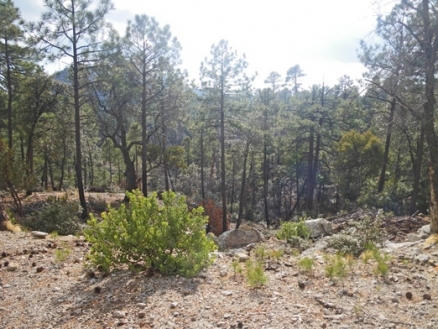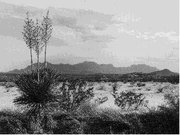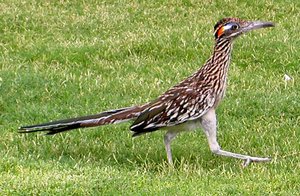Chihuahuan Semidesert Province
Contents
Chihuahuan Semidesert Province (Bailey)
The Chihuahuan Semi-Desert Province is found in southeastern Arizona, southern New Mexico, western Texas, 85,200 mi2 (220,700 km2) in the southwestern USA, and portions are also found in northern Mexico.
Land-surface form
This province is mostly desert. Practically the only permanent streams are a few large rivers that originate in humid provinces. The Rio Grande and the Pecos Rivers and a few of their larger tributaries are the only perennial streams. The area has undulating plains with elevations near 4,000 ft (1,200 m), from which somewhat isolated mountains rise 2,000 to 5,000 ft (600 to 1,500 m). Washes, dry most of the year, fill with water following rains. Basins with no outlets drain into shallow playa lakes that dry up during rainless periods. Small whirlwinds constantly play over these dry playas when they are heated by summer sun. Extensive dunes of silica sand cover parts of the province. In a few places there are dunes of gypsum sand, the most notable being the White Sands near Alamogordo in southern New Mexico. In scattered areas, small beds and isolated buttes of blackish lava occur.
Climate
Summers are long and hot. Winters are short, but may include brief periods when temperatures fall below freezing. Average annual temperatures range from 50 to 65F (10 to 18C). The climate is distinctly arid; spring and early summer are extremely dry. Mean annual precipitation at El Paso, Texas, is 8.65 in (221 mm). In July, summer rains usually begin, torrential storms that are mostly local and continue through October. The northern part of the province also receives winter rains, which are more gentle and widespread.
Vegetation
A number of shrubs, most of them thorny, are typical of the Chihuahuan Desert. They frequently grow in open stands, but sometimes form low, closed thickets. In many places, they are associated with short grass, such as grama. Extensive arid grasslands cover most of the high plains of the province. On deep soils, honey mesquite is often the dominant plant. Cacti are also abundant, particularly prickly pears, but they are smaller in size and fewer in number of species than in the Sonoran Desert. The desert is characterized by yuccas, so much so that one has been adopted as the state flower of New Mexico. A few cottonwoods and other trees grow beside the widely separated rivers. Creosote bush, which covers great areas in characteristic open stands, is especially common on gravel fans. Though creosote bush is the most abundant plant cover of the province, other species like lechuguilla are also abundant. Another distinctive plant is candelilla, or wax plant. On rocky slopes, the ocotillo is conspicuous. Juniper and pinyons, limited to rocky outcrops, are prominent around the Stockton Plateau in western Texas.
Some isolated mountains in the Chihuahuan Province rise high enough to carry a belt of oak and juniper woodland. On a few of the highest mountains, there are pines among the oaks, in some places forming nearly pure stands. Douglas-fir and white fir occupy a few sheltered upper slopes in the Santa Catalina Mountains.
Soils
In the western and northern portions of this province, the soils are primarily Aridisols. Both Aridisols and Entisols are present in the south.
Fauna
Pronghorn antelope and mule deer are the most widely distributed large game animals. Whitetail deer inhabit parts of Texas. The collared peccary or javelina is common in the southern part of the region. The blacktail jackrabbit, desert cottontail, kangaroo rat, wood rat, and numerous smaller rodents compete with domestic and wild herbivores (Herbivory) for available forage. Mammalian predators include the coyote and bobcat.
The black-throated sparrow is one of the most abundant birds of the province. Greater roadrunner, curve-billed thrasher, and Chihuahuan raven are also common. Scaled quail and Gambel's quail occupy most of the area, and bobwhite populations reach into its eastern portion. Raptors include the golden eagle, great horned owl, red-tailed hawk, ferruginous hawk, and the rare zone-tailed hawk.
The many reptiles include the common chuckwalla, Texas horned lizard, desert spiny lizard, and various species of rattlesnakes.
Return to Ecoregions of the United States
| Disclaimer: This article contains information that was originally published b, the United States Forest Service. Topic editors and authors for the Encyclopedia of Earth have edited its content and added new information. The use of information from the United States Forest Service should not be construed as support for or endorsement by that organization for any new information added by EoE personnel, or for any editing of the original content. |


